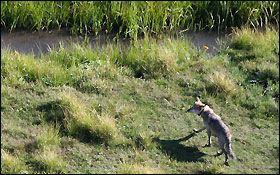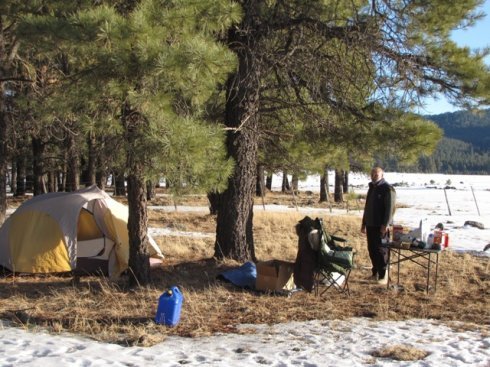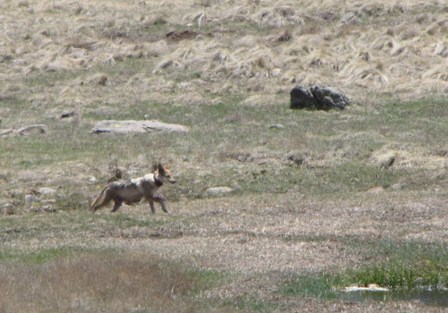
(Click on logo to visit site and support this awesome group)
News Brief, AZ Game and Fish Update, and More on Forest Fire in Mexican Wolf Recovery Area (posted 6/5/11)
A fire in eastern Arizona, called the Wallow Fire, has burned through the White Mountains and threatens the safety of Mexican wolf packs. Below, we have included information from a variety of sources, including a Phoenix KPHO news brief, an excerpt from a report from AZ Game and Fish Department, and a link to the White Mountain Independent, which is posting frequent updates on the fire. Our hopes are for the safety of the wolves and pups, as well as the human residents of the area. We will post more information as it becomes available.
 Phoenix KPHO News: Wildfire Threatens Endangered Mexican Wolves, June 3, 2011Wildlife officers are on the ground in the area of the Wallow Fire to help any animals that could be affected by the fire.
Phoenix KPHO News: Wildfire Threatens Endangered Mexican Wolves, June 3, 2011Wildlife officers are on the ground in the area of the Wallow Fire to help any animals that could be affected by the fire.
One main priority is the survival of four packs of endangered Mexican wolves that live in the area.
The Arizona Game and Fish Department is worried the fire could destroy a den where one of the packs is raising some pups.
Officials say they can't remove the pups and return them later because the adult wolves would not accept them.
Some burnout operations have been conducted in hopes of protecting the dens.
You can view the KPHO story online here.
********************************************************
Excerpt from AZ Game and Fish Department, June 3 Wildlife News
Wildlife officers assist with human and wildlife impacts as Wallow Fire grows
 As the Wallow Fire continues to grow and impact eastern Arizona’s landscape – displacing residents and threatening livelihoods – wildlife officers are on the ground helping evacuate residents, protect structures and mitigate the effects on wildlife. The fire has burned nearly 106,000 acres as of early June 3 and is at zero percent containment.
As the Wallow Fire continues to grow and impact eastern Arizona’s landscape – displacing residents and threatening livelihoods – wildlife officers are on the ground helping evacuate residents, protect structures and mitigate the effects on wildlife. The fire has burned nearly 106,000 acres as of early June 3 and is at zero percent containment.
An interagency team is monitoring the effects of the fire on the endangered Mexican wolf population that lives in the area.
Two of four wolf packs that are known to reproduce regularly in Arizona – the Rim and Bluestem Packs -- are in the immediately impacted area of the fire. Young pups have been confirmed for the Bluestem Pack, and the Rim Pack is displaying behavior that is consistent with denning activity. However, the fire’s impact on these wolves thus far has been low.
As part of a larger containment strategy, a low-intensity fire was ignited along the fireline north of the Black River to remove ground-level fuels and help prevent a high-intensity fire in the vicinity of the Bluestem Pack. This burnout was intended to reduce the intensity of the main fire when it burns through the denning area and is an important step promoting the survival of the pups associated with this pack.
“Fire is a natural part of the ecosystem for all wildlife, including this wild population of Mexican wolves,” said Chris Bagnoli, Arizona Game and Fish’s Interagency Field Team (IFT) Leader for the wolf reintroduction. “The team has to balance the desire to help protect the affected wolves, while also preserving the bond between the pups and the adults and not putting fire crews at risk. Unfortunately, removing the pups now and returning them to the den later isn’t an option as the adults will not accept them later.”
The fire also has the potential to affect the Hawks Nest Pack, which is denning several miles away from the where the front line of the fire is as of June 3. The team will continue to monitor this pack as the fire progresses in their direction.
 The Eastern Arizona Type II Incident Management Team, commanded by John Philbin, is also assisting in the wolf monitoring effort. The team has allowed project personnel to use a helicopter for survey flights, which have located both the Rim and Bluestem Packs by their telemetry collars. The information obtained from the collared wolves confirms that they are still located adjacent to den sites, indicating that the pups are most likely still alive.
The Eastern Arizona Type II Incident Management Team, commanded by John Philbin, is also assisting in the wolf monitoring effort. The team has allowed project personnel to use a helicopter for survey flights, which have located both the Rim and Bluestem Packs by their telemetry collars. The information obtained from the collared wolves confirms that they are still located adjacent to den sites, indicating that the pups are most likely still alive.
“As an element of a fire-adapted ecosystem, these are wild wolves and like most wildlife, they have an amazing ability to move in response to wildfire,” Bagnoli said. “Forest service personnel reported seeing one of the Bluestem pack members and at least one pup of the year during operations Wednesday so we know that the pups are still being tended by the adults.”
The Interagency Field Team will monitor the after-effects of the fire and may provide supplemental feeding if the wolf’s prey base diminishes significantly immediately after the fire. The fire is expected to initiate regrowth in the next couple of years that will help provide plenty of forage for elk, mule deer and white-tailed deer.
Mexican wolf reintroduction is a joint effort by the U.S. Fish and Wildlife Service, Arizona Game and Fish Department, New Mexico Department of Game and Fish, White Mountain Apache Tribe, USDA Forest Service, USDA Animal and Plant Health Inspection Service - Wildlife Services, and other local stakeholders.
**************************************************************************
You can read White Mountain Independent updates on the fires here.
Photos, top to bottom: Collared Hawks Nest pack wolf, courtesy of USFWS, Camping in the recovery area, courtesy of Jean and Peter Ossorio, Mexican wolf in Hawks Nest territory, courtesy of Jean Ossorio
 Phoenix KPHO News: Wildfire Threatens Endangered Mexican Wolves, June 3, 2011Wildlife officers are on the ground in the area of the Wallow Fire to help any animals that could be affected by the fire.
Phoenix KPHO News: Wildfire Threatens Endangered Mexican Wolves, June 3, 2011Wildlife officers are on the ground in the area of the Wallow Fire to help any animals that could be affected by the fire.One main priority is the survival of four packs of endangered Mexican wolves that live in the area.
The Arizona Game and Fish Department is worried the fire could destroy a den where one of the packs is raising some pups.
Officials say they can't remove the pups and return them later because the adult wolves would not accept them.
Some burnout operations have been conducted in hopes of protecting the dens.
You can view the KPHO story online here.
********************************************************
Excerpt from AZ Game and Fish Department, June 3 Wildlife News
Wildlife officers assist with human and wildlife impacts as Wallow Fire grows
 As the Wallow Fire continues to grow and impact eastern Arizona’s landscape – displacing residents and threatening livelihoods – wildlife officers are on the ground helping evacuate residents, protect structures and mitigate the effects on wildlife. The fire has burned nearly 106,000 acres as of early June 3 and is at zero percent containment.
As the Wallow Fire continues to grow and impact eastern Arizona’s landscape – displacing residents and threatening livelihoods – wildlife officers are on the ground helping evacuate residents, protect structures and mitigate the effects on wildlife. The fire has burned nearly 106,000 acres as of early June 3 and is at zero percent containment.An interagency team is monitoring the effects of the fire on the endangered Mexican wolf population that lives in the area.
Two of four wolf packs that are known to reproduce regularly in Arizona – the Rim and Bluestem Packs -- are in the immediately impacted area of the fire. Young pups have been confirmed for the Bluestem Pack, and the Rim Pack is displaying behavior that is consistent with denning activity. However, the fire’s impact on these wolves thus far has been low.
As part of a larger containment strategy, a low-intensity fire was ignited along the fireline north of the Black River to remove ground-level fuels and help prevent a high-intensity fire in the vicinity of the Bluestem Pack. This burnout was intended to reduce the intensity of the main fire when it burns through the denning area and is an important step promoting the survival of the pups associated with this pack.
“Fire is a natural part of the ecosystem for all wildlife, including this wild population of Mexican wolves,” said Chris Bagnoli, Arizona Game and Fish’s Interagency Field Team (IFT) Leader for the wolf reintroduction. “The team has to balance the desire to help protect the affected wolves, while also preserving the bond between the pups and the adults and not putting fire crews at risk. Unfortunately, removing the pups now and returning them to the den later isn’t an option as the adults will not accept them later.”
The fire also has the potential to affect the Hawks Nest Pack, which is denning several miles away from the where the front line of the fire is as of June 3. The team will continue to monitor this pack as the fire progresses in their direction.
 The Eastern Arizona Type II Incident Management Team, commanded by John Philbin, is also assisting in the wolf monitoring effort. The team has allowed project personnel to use a helicopter for survey flights, which have located both the Rim and Bluestem Packs by their telemetry collars. The information obtained from the collared wolves confirms that they are still located adjacent to den sites, indicating that the pups are most likely still alive.
The Eastern Arizona Type II Incident Management Team, commanded by John Philbin, is also assisting in the wolf monitoring effort. The team has allowed project personnel to use a helicopter for survey flights, which have located both the Rim and Bluestem Packs by their telemetry collars. The information obtained from the collared wolves confirms that they are still located adjacent to den sites, indicating that the pups are most likely still alive. “As an element of a fire-adapted ecosystem, these are wild wolves and like most wildlife, they have an amazing ability to move in response to wildfire,” Bagnoli said. “Forest service personnel reported seeing one of the Bluestem pack members and at least one pup of the year during operations Wednesday so we know that the pups are still being tended by the adults.”
The Interagency Field Team will monitor the after-effects of the fire and may provide supplemental feeding if the wolf’s prey base diminishes significantly immediately after the fire. The fire is expected to initiate regrowth in the next couple of years that will help provide plenty of forage for elk, mule deer and white-tailed deer.
Mexican wolf reintroduction is a joint effort by the U.S. Fish and Wildlife Service, Arizona Game and Fish Department, New Mexico Department of Game and Fish, White Mountain Apache Tribe, USDA Forest Service, USDA Animal and Plant Health Inspection Service - Wildlife Services, and other local stakeholders.
**************************************************************************
You can read White Mountain Independent updates on the fires here.
Photos, top to bottom: Collared Hawks Nest pack wolf, courtesy of USFWS, Camping in the recovery area, courtesy of Jean and Peter Ossorio, Mexican wolf in Hawks Nest territory, courtesy of Jean Ossorio

No comments:
Post a Comment